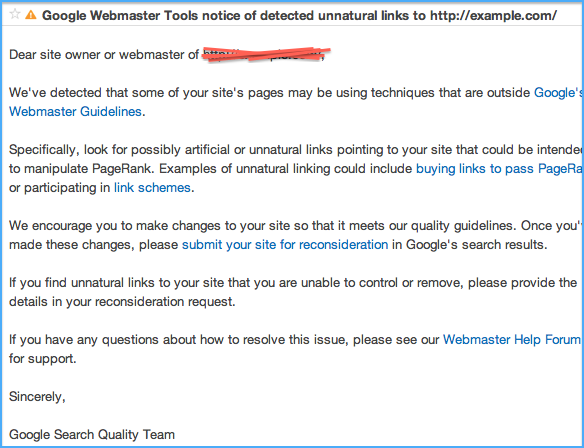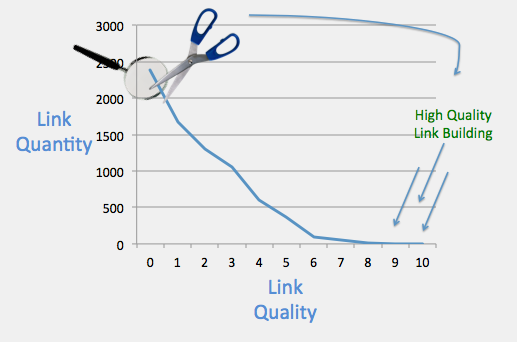As you probably know, Google’s recent Penguin update focused on lowering rankings for sites that use questionable link building practices.
This is a hot topic! If you have been hit by Penguin, or are worried about future variations of the algorithm, this is a video you can’t miss. In fact, regardless of your current situation, pruning the worst links out of your profile is a rock solid idea.
Key Points
- Link pruning refers to the identification and removal of unnatural, non-organic, or generally spammy links from a link profile.
- In many cases, questionable link building tactics (buying links, spamming links) can result in an eventual loss of rankings.
- In the event of a loss of rankings (or warning from Google) due to unnatural link profiles, it sometimes makes sense to investigate a link profile, find the low quality links, and send requests to their webmasters for removal.
- Many times, getting a link removed from a webmaster can be as difficult, if not more difficult, then getting the link in the first place.
- The key to this process is persistence and communication with Google.
- Sometimes, the best you can do is send a list of the links you are trying to remove, and ask Google to discount them. Showing an effort to Google is always a good plan of action.
- When removing links, don’t expect to return to your pre-penalty rankings. You must replace the spammy links that were detected with quality links, which can sometimes be a lengthy process.
- Link pruning should be considered every month. Ask yourself: What is the bottom 5 percent of links that I have in terms of quality? How can I remove these and replace them with quality links?
Full Interview Transcript
Eric Enge: Hi, I’m Eric Enge of Perficient Digital. I’m here today with Bruce Clay. Bruce, take this moment and tell us a little bit about yourself.
Bruce Clay: Bruce Clay has been in business since 1996. We started out as a pure play SEO company. We’ve now expanded into other areas of internet marketing optimization. We do SEO, PPC, analytics. We’re Omniture-certified, as an example. We do conversion rate optimization, social media, and a lot of design architecture work.
 |
We are probably well-known for speaking at conferences. We wrote the Wiley book Search Engine Optimization All-In-One for Dummies. We do a lot of courses. I sponsor a lot of conferences, the Search Engine Strategies and Search Marketing Expo. I think I’m either notable there for being a speaker, a teacher, an exhibitor, a sponsor.
I think most people remember me because I provide drink tickets.
Eric Enge: That’s an important benefit that you bring to attendees.
Bruce Clay: Yes. So, I think networking is important. So, we’re pretty well-established, I think, in the industry and we hope to continue to, obviously, grow within that space.
Eric Enge: Yes, super. So, Bruce, you and I chatted a little bit offline here about this notion of link pruning. And, you know, what we’re really talking about here is a site that may or may not have gotten the problem in terms of being flagged by Google. But they know they have a problem in terms of their link profile. Too many links from unrelated sources, or purchased, or whatever they might be. Can you talk a little bit about how you think about link pruning?
 |
Bruce Clay: Yes. We started doing what we call link pruning. It wasn’t really; it’s still not a mainstream term, but it really does apply to what we do.
Perhaps six, eight months ago, we had a client at one point that was very, very well-ranked, but they felt that links were; they bought into the Kool-Aid, if you will. They understood that links were important, and they thought it was important and they talked to us and we’ve always been a firm that attracts links instead of recruiting links, if you will. We don’t buy them. We don’t do that.
So, really, about a year and a half; two years ago, they bought into that concept. Somebody sold them the bill of goods. They had been with us for a while, so they said, “Oh, new eyes. Let’s try this.” They went out and that person immediately started buying links and spamming links. Blog links. All sorts of really spammy kinds of things.
They took their rankings, which were significant, and they lost them all. They came back to us and then all of sudden we’ve got a site that we were familiar with, on page looked good, but off page was absolutely a disaster. And we felt by the evaluation that what they had done was burned their trust scores.
So, what had happened is their PageRank had gone up and their trust had gone down. They found themselves nowhere in the first three, four, or five pages of ranking. It was time to do a repair.
And in the world of finance, there are two ways to make money. You either sell more or you spend less. Because the difference is where you’re at. And as any good numerator/denominator system seems to be, in this particular case, the biggest bang for the buck was actually in removing the bad links instead of trying to overcome them with more good links.
Eric Enge: Right.
Bruce Clay: So, we invented this term called link pruning, and in the link pruning process what we do is we attempt to determine the quality of the sites that actually link to you. We started by subscribing to Majestic SEO. We used their ACRank score to determine the probable lower match kind of things.

And then we manually went into all of the lowest-scored pages and we determined whether or not they were organic or inorganic inbound links. And where we determined that they were off-topic or spammy or low-quality blog links or things that looked like they had been acquired instead of earned.
We solicited either a no-follow or removal of the link themselves. That turned out to be a rather lengthy process. For anybody that has ever tried to, “Dear Webmaster, please link to me,” getting rid of links is twice as bad.
Eric Enge: Yes, exactly. Even if you paid for it originally, they don’t want to spend the time to take it off.
Bruce Clay: Yes, because it’s going away. I mean, they make no money if you do that. They’re in no hurry to do that. In some of the cases, we found that even though, through this link network they bought into, they were paying for the links, even when they stopped paying for the link, the link didn’t go away. So, the penalty remained because the link was still there. They stopped paying for it, but that didn’t eliminate it.
Eric Enge: So, how do you deal with that problem, then?
Bruce Clay: Well, you have to be somewhat persistent. You have to request in writing a couple of times. If you can determine who it was that did it through this network, sometimes going to them, they have more juice with those individual sites than you ever would. So, you know, we would attempt to determine where the originator of the link request came from and work through them as an intermediary.
The problem you also face (and we ran into this) is some of them knew they were junk sites. And this is something really bizarre because I didn’t expect it. When they knew that they were a junk site, as soon as we requested that they remove the link, they sent us an email saying, “We will remove your links for $10 a link.” Almost as if they put the link in knowing that eventually you would have to ask them to remove and it and that would be how they would make their money.
Eric Enge: Yes.
Bruce Clay: I think it’s kind of hard to tell. When things like that happen, you know, there’s only one thing you do is you take that email and you forward it off to Google. Because it’s a good reason why I can’t get rid of my links.
Eric Enge: Right. Well, and that, I think, is a big part of the strategy, right? Because at the end of the day you can’t get all your links removed. It’s not gonna happen. So, what we’ve seen work is you create a Google Doc, you send in a reconsideration request, you point to the Google Doc, and say, “Hey, I tried to get these removed. I couldn’t. Please just discount them.”
Bruce Clay: Yes. And, quite frankly, Google hasn’t; again, there’s no ruler for measuring how many I have to get rid of. It’s a subjective kind of a thing. In some cases, they say that you have demonstrated, on a good-faith basis, that you are removing them, continue to remove them, let us know later. In some cases, you’re demonstrating it, you’ve done a good enough job, we’ll let you back in.
The belief is that if Google actually penalizes you for these bad links, unfortunately, this is a customer belief, that if I was ranked on page 3, I buy the links, I move up to page 1. I get penalized to page 5. We remove the links, you move back up to page 3. The customer is generally upset because they didn’t move back up to page 1.
Well, the only reason you were on page 1 is because you were pre-spam. But we have customers that were upset because, “Hey, I really enjoyed being there. I asked you to fix my links and you haven’t gotten me back to page 1.” Which is two entirely different situations. Sometimes getting back to where you were before the bought the links is all you can really expect.
Eric Enge: Right. So, we won’t have time for it in today’s video, but obviously, then, that says that the next thing you do is you work on building good quality organic links to get you back there. But at least by having gone through this process will have taken the problem out of the mix.
Bruce Clay: Well, we hope. As an ongoing thing, by the way, there’s maintenance to this. I mean, every month you should say: What is my 5 percent worst links, how do I prune that 5 percent and add in 5 percent at the top? How do I churn my link network to have a generally better quality?
 |
Because, believe me, Google’s gonna keep turning that dial. It’s gonna tighten down and what made it through last month may not make it through this month. So, the surprise of Google.
Eric Enge: Awesome. Well, great talk, Bruce. I enjoyed it a lot. Thanks very much.
Bruce Clay: Thank you.
